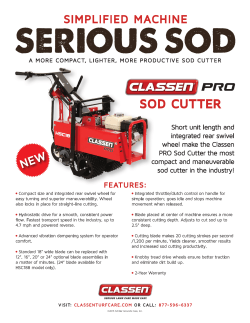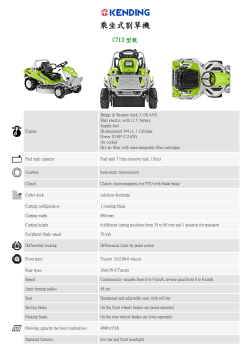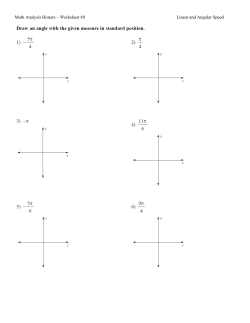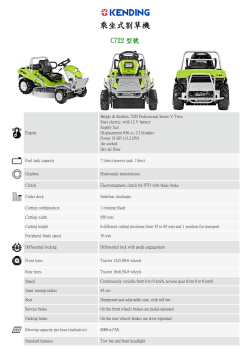
Spring 2010 - Lumber Smith
The Lumber Smith Sawyer Newsletter Number 3 – Spring 2010 www.lumbersmith.com President’s Message By Albert Pollard, Jr. Be sure to visit our web site to review past newsletters. Go to www.lumbersmith.com, select Scrapbook, click Newsletters. You will find helpful information about the saw and blades. At the end of each newsletter we’ve put some helpful links. New Products We’ve added some products to the web site. They are: Drip Kit We have used the Drip Kit while we cut lumber and it seems to improve the speed of cutting, especially with harder woods like white oak and hickory, improves blade life and helps the blade to maintain its sharpness. The Drip Kit sells for $75. Lift Assembly The Lift Assembly is made of stainless steel and aluminum similar to the saw itself. The Lift Assembly allows the sawyer to easily lower the saw after each cut precisely – this enables the sawyer to make the next cut accurately time after time. The true test of the Lift Assembly is to look at the stickered wood (wood that is drying) to see how consistent board thickness is. The Lift Assembly sells for $200. Blade Packs We have developed 3 Starrett blade packages – 2 are new. They are: Part # B2 B5 B10 Blade Packages Blades ($25/blade), includes shipping Blades ($22/blade), includes shipping Blades ($18/blade), includes shipping Qty. 2 5 10 Price $50.00 $110.00 $180.00 Manufacturer’s Representative Program This quarter we began our Manufacturer’s Representative program. We did this as many prospects like to talk to saw owners and sometimes see the saw in action before they purchase a saw. To that end, we developed the program. As a Lumber Smith sawmill owner, we believe there are a number of you who have: • Experience with the sawmill • Can use the sawmill effectively • Good personal computer skills • The ability to communicate effectively • Would like to be a Lumber Smith Sawmill Manufacturer’s Representative While this is not work that will make you independently wealthy, it is relatively easy work and should provide some revenue. If interested, email or call Eddy Whichard (804-577-7398, ewhichard@lumbersmith.com) for more details. To date, we have 12 saw owners who have signed up. It’s About the Outcome By Eddy Whichard Blade Tensioning and Sharpness While cutting wood, sometimes my cutting speed slows; my blade might be dull, I might be coming into a knot or I may be cutting harder wood than normal. When that happens, I: Don’t Push Harder on the Saw – When I push harder on the saw it causes the blade to “wander” in the cut producing a wavy board. It also causes the blade to run against the back bearings harder than the bearings can stand. Over a short time, the bearings will score, stop turning and the blade back will actually cut the top of the bearing off. If I continue to push hard on the saw, the blade will migrate so far back in the saw case that it will cut the tensioning rod. In this instance, I’m out of business until I replace the tensioning rod. I never push harder on the saw than I normally do. Don’t Increase Blade Tension – When I see the blade waiver in the cut, I never increase blade tension. When blade tension is increased, the case flexes so that the drive and idle wheels both turn slightly to the inside of the case. Try this on your saw…tension the blade, remove the cover, stay behind the saw, start the motor, run at idle, change the tension one revolution, loose and then tight. Notice the position of the blade on the drive and idle wheels when you do this. When the tension is increased, the blade moves into the saw case. When decreased, the blade runs to the outside of the case. In either instance, this is not good for the back bearings and possibly the tensioning rod. Use Constant Pressure and Appropriate Blade Tension - I continue to exert consistent pressure on the saw AND be consistent with blade tension. I always use my tension tool. Lastly, if the blade is dull, I replace or sharpen it. If the blade is so dull that it will not cut, I stop the saw, slowly back the saw and blade out of the cut and replace or sharpen the blade. When I use constant pressure and appropriate blade tension, my life is made easier. Blade Break-in Procedure A new band saw blade has razor sharp tooth tips as a result of forming the teeth. In order to withstand the cutting pressures used in band sawing, the tooth tips should be honed to form a micro-fine radius. Cutting with high pressure without honing causes microscopic damage to the tooth tips, resulting in a shorter blade life. Completing a proper break-in procedure on a band saw blade will increase blade life. To get long life from a new band saw blade – follow this procedure: Use the appropriate band saw speed for the material to be cut. Run saw at 75% Reduce the feed rate (force on the saw) to achieve a cutting rate of approximately 20% to 50% of the normal cutting rate. Mild steel blades (carbon steel) require a greater reduction in feed rate. Feed rate 20% - 50% Begin the first cut at the reduced rate, making sure the teeth are forming sawdust chips. Once the blade fully enters the log or workpiece, the feed rate can be slightly increased. Increase feed rate to 50% Make gradual increases in the feed rate (force on the saw) over several cuts until the normal feed rate is established (something like 3-4 ft. per minute depending on width of cut and wood hardness). Gradually increase feed rate to 100% During break-in, adjustments to band speed may be made in the event of excess noise, blade vibration or blade chatter. Once the blade is broken in, use 50% to 100% blade speed depending upon on width of cut and wood hardness. Insure the sawdust in made up of wood chips, not light dust. Gentlemen, Start Your Engines! Try this the next time you cut wood - Don’t run the engine at full speed. Run at a reduced speed, allow the blade to cut and evacuate the sawdust, look at the sawdust – it should be more granular. Depending upon the wood, cutting speed (feet/minute) may increase. Photos and Comments - Please share photographs of you with the saw in action, your finished work, what it is made of and your experiences using the saw (photos, 1-2 paragraphs and the dimensions if possible). We will send 2 free blades for each article we select for being published in our newsletter. In addition, we publish these photos and articles on our web-site. From Jared – Melborne, FL From Rich and Josh – Shelton, CT My first log (oak), satisfaction after finishing first 12"X12"X6' Some tamarack logs to be made into 1"X12" Tamarack made into 1"X12". I couldn't believe how well the mill cuts. It uses no gas. The original blade is still going great! I'm still admiring my work! Did you ever see the Watlon's on TV back in the 1980s? The father had as old truck and ran a sawmill. This is my "V" rail. I used 5/16"X3" lag bolts with 3/8" nuts for spaces to fasten it together. It works great! This is my way to tie off the blade when removing it. It's simply a bunge cord strap. The plastic hooks on the ends snap snugly into the saw handles. I use a 5 gallon plastic container with a tool sleeve to hold all the things I need when using the mill. For easy and quick removal and reinstalling the cover, I use wing nuts with large washers. This eliminates the need for a wrench. Keeping it simple otherwise people will leave the cover. From Steve – Big Lake, MN From Jim - Opelika, AL Final thought on this quarter’s photos – let’s forget about the saw and ride in the Ford!!!!!! Email your submissions to: ewhichard@lumbersmith.com or mail to: Eddy Whichard Lumber Smith PO Box 269 Mollusk, VA 22517 Useful Links to Information From time to time we find wood related information on the internet that we find interesting and believe it might be useful to other sawyers. We hope you find these links informative. Solar Kiln - http://www.pubs.ext.vt.edu/420/420-030/420-030.html Band Saw Blade Information - http://www.bandsawbladesdirect.com/ and http://www.allbandsawblades.com/problems_How2.htm Reducing Checking in Green Wood with Wax Emulsion Sealers http://www.woodturningvideosplus.com/wax-emulsion.html
© Copyright 2025









